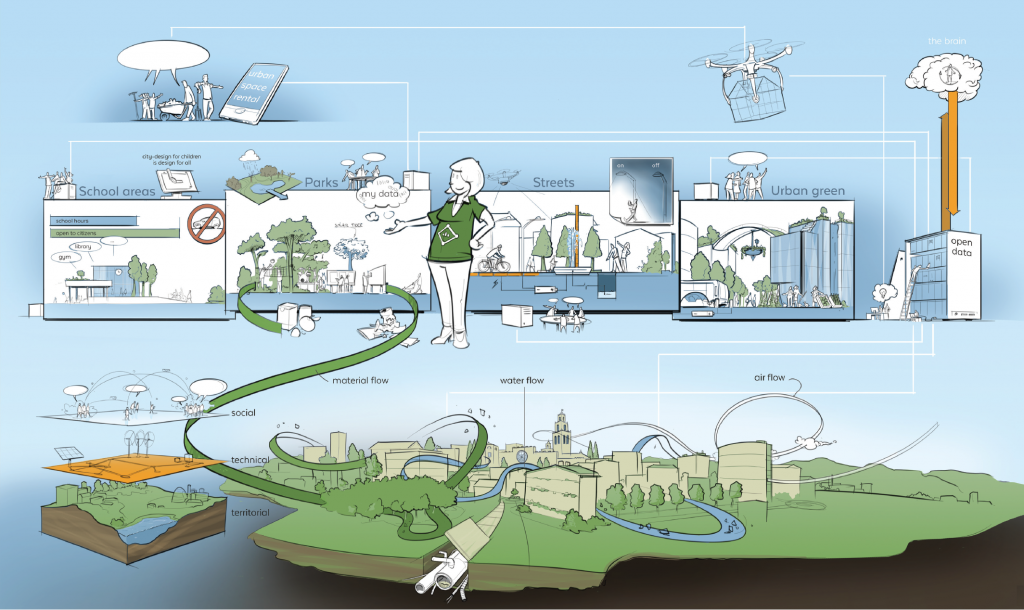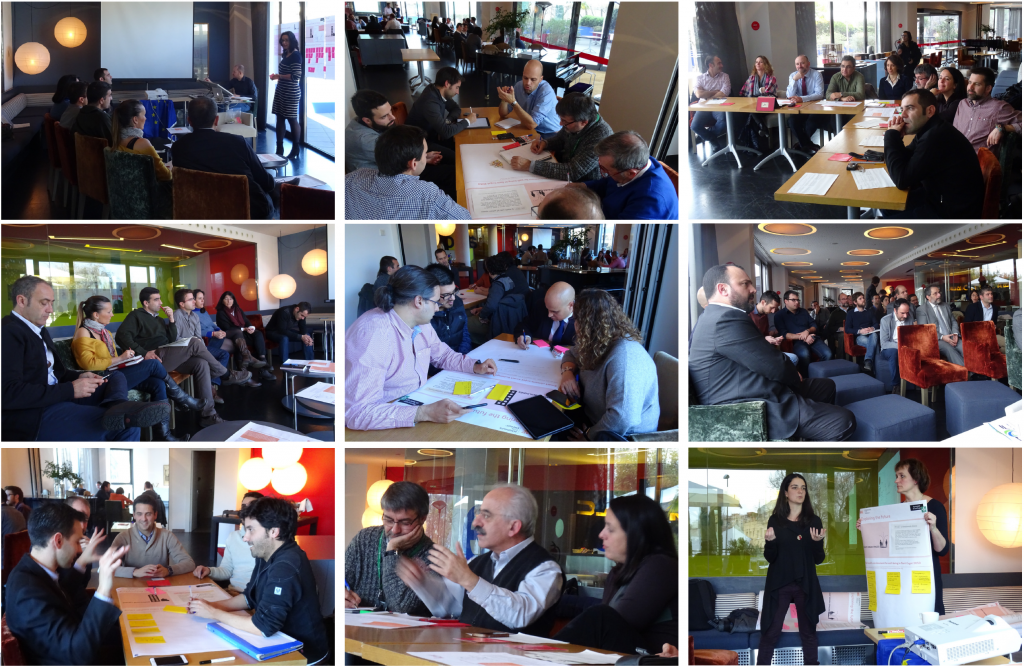Sant Cugat Vision Development 2050

Vision development for Sant Cugat 2050
The R4E project has completed the “Vision development” stage, which consisted of designing the services and characteristics that our cities should offer in the year 2050, based on the opinions and contributions of municipal experts of each city, their stakeholders, politicians and municipal managers. To better illustrate the process, images have been created that reflect the way our cities could look in 2050, including the services and characteristics agreed upon in the workshops for each of the project’s focus areas.
SMART CITIZENS ENJOY SMART BUILDINGS IN SANT CUGAT 2050
In 2050, all the stakeholders in Sant Cugat value collaboration and shared responsibility to manage their energy pro-actively. Both owners and occupiers of buildings value the opportunity to save energy and water.
They do this by using the latest energy-saving technologies and energy- efficient system designs. These concepts add up to significant energy savings. But people don’t have to make any compromises on the comfort of their (living) environment. The latest technologies are also applied in the materials used in buildings and in the urban space. For example with materials that can clean the air, and take advantage of the kinetic energy of cars, bikes and pedestrians, transforming this energy into other forms that are useful for citizens.
Renewable resources are valued because they create a self-sufficient smart energy grid connecting all the individual buildings and neighbourhoods. The desired future scenario makes a distinction between the different type of buildings — family houses, apartments, public buildings and offices — addressing specific opportunities and solutions. Those solutions can also be applied in other areas and categories when the need arises.
What characterises the city of Sant Cugat in the focus areas of Smart Buildings and Smart Urban Spaces and the elements of the desired future scenario are:
1. Smart communities
In 2050, owners of family houses are aware of the need for sustainable energy, water and waste services. They invest in systems and share them with their neighbours, so together they can afford a range of solutions for energy (generation and storage), water, food and waste. Together, they form a self-sufficient community. Smart homes provide a high level of comfort, with easy access to services like healthcare, so people can continue to live independently in their own homes.
2. Saving through sharing
Apartments in 2050 provide both shared and private areas and services. Next to gyms, gardens and swimming pools, sharing also extends to kitchen, dining areas, office spaces for teleworking, and many other facilities. Green roofs provide shared gardens and urban farming spaces. These are interconnected to provide green walking routes. Basements offer common parking spaces for bikes and charging points for shared vehicles.
3. Empowerment by example
Public buildings in 2050 are like a service rather than just a space. They make efficient use of space by adapting to the needs of the users – e.g. smart services to optimise behaviour. Nature and natural resources are used, like plants and green, to reduce the impact of the building. Public buildings are showcases for the highest possible energy efficiency and teach and empower citizens towards sustainable behaviour.
4. Campuses as incubators
In 2050, offices and campuses are small villages in themselves, providing local facilities and services. They open up to citizens and connect to the community. The controlled environment of campuses and the predictable patterns of use, make them ideal incubators to test new solutions for energy exchange, self-driving mobility and other shared services. All systems use and provide open data, supporting start-ups in developing new business.
5. Open smart grid
In 2050, a smart grid connects all buildings and public services. The system is accessible by all users and providers of energy, water and other resources (waste disposal). It allows users to choose from a range of available options. It brings together supply and demand, anticipating weather and other conditions and use patterns. The system enables self-sufficiency at city level. It uses open data, although citizens are in charge of their own data and of the system.
HIGH-QUALITY ENVIRONMENT FOR WELL-BEING IN SANT CUGAT 2050
In 2050, the citizens of Sant Cugat enjoy a high-quality environment for well-being. People feel responsible for sustainability and engage in collaborative urban planning, use and maintenance.
A high-quality living environment supports healthy lifestyles. An ecological system connects the green areas and enables multifunctional use of urban spaces. The result is an increase in social activities, and in walking and cycling.
The newest technologies are applied in the materials used in buildings and urban spaces. For example, materials that can clean the air and take advantage of the kinetic energy of cars, bikes, and pedestrians transforming this energy into other forms that are useful for citizens. Circular systems for water, food, waste and energy are managed efficiently for maximum re-use of resources.
The environment is designed around people as users of different urban spaces, such as school areas, parks, streets and urban green (visualised in the top layer of the desired future scenario). The spaces are supported by smart systems to allow for a variety of services. All subsystems are balanced by the city ‘brain’ (top right) This is all brought together in the city landscape as a holistic city ecosystem, in which all materials, water and air flows are of high quality.
1. Empowered people
People are proud to live and/or work in Sant Cugat. They drive initiatives, supported by the administration. Social discussion groups (with good representation of the community) co-create their living environment. A database with the latest data and historical knowledge supports living with lower use of resources. Visibility of the (now invisible) infrastructure and resources enables responsible management and anticipation by citizens themselves.
2. Multi-use of urban space
The urban spaces all over the city are used more flexible and cater for different activities. Spaces can be rented for short-term use (e.g. playing football) or for longer-term use (e.g. urban gardening) through an app. Facilities can also be booked, and will be tuned to the activity (business meetings, sports and games, picnics etc.). Citizens engage in social activities with respect for the environment and for other people. The elderly, children and the disabled can use the spaces safely.
3. Resilience of the city
The resources available in the different areas are shared at city level in a circular system. This is done territorially — to understand and monitor the (natural) resources; socially — to enable the awareness and interests of people; technologically — a system and grid to make the resources accessible and to respond to changes and emergencies; and economically — to allow continuous improvement. In a ‘system-of-systems’, everything is connected and maintained as a single infrastructure.
4. Open data & smart grid
The system includes a centralised data base containing different types of data from different stakeholders on all services and assets in the city. The ‘brain’ of the system anticipates the expected use and conditions, suggests actions suited to users’ needs and optimises the use of the infrastructure and resources. It enables people to make choices in complex situations. The data is accessible for the development of new apps and services by entrepreneurs.
5. Financing model
New solutions and systems are needed, and these require new financing models and cooperation by the stakeholders. The administration and social conscious citizens jointly invest in the living environment. Public spaces, resources and data are used for valuable new services (e.g. food delivery for picnics in the park or the use of spaces as terraces) to generate revenue enabling sustainable business and further investments.
All these ideas and input have emerged from the participatory workshops that have taken place in the city of Sant Cugat and whose images can be seen below:



Leave a Comment